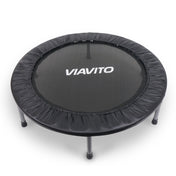When it comes to improving fitness and burning fat, two cardio styles dominate the conversation: HIIT (High-Intensity Interval Training) and steady-state cardio. Both methods work - but they affect your body differently. So which one gets you fit faster? And which is better for fat loss?
What Is HIIT and Why Is It So Popular?
HIIT involves short bursts of very intense effort followed by brief rest periods.
Example: 30 seconds fast / 30 seconds slow, repeated for 10–20 minutes.
Key benefits of HIIT:
- Burns more calories in less time
- Boosts metabolism for hours (afterburn effect)
- Improves VO₂ max (a key fitness marker)
- Efficient for busy schedules
- Great for fat loss, especially belly fat
- Keeps workouts varied and motivating
HIIT is ideal if you want fast results with short sessions.
What Is Steady-State Cardio?
Steady-state cardio means maintaining a consistent pace for a longer period - e.g., a 30-minute jog, brisk walk or cycling session.
Benefits of steady-state:
- Lower impact, easier to maintain
- Great for mental relaxation
- Ideal for beginners
- Great for building aerobic base
- Burns calories without spiking fatigue
- Supports daily consistency
For many people, steady-state is more enjoyable and therefore more sustainable.
HIIT vs Steady-State: Which Is Better for Fat Loss?
HIIT for fat loss:
- Burns more calories per minute
- Increases afterburn for hours
- Ideal for quick, time-efficient fat burning
- Helps preserve muscle while losing fat
Steady-state for fat loss:
- Easier to perform more often
- Burns a moderate number of calories but over a longer time
- Doesn’t spike hunger as intensely as HIIT
- Great for people who struggle with high intensity
Verdict:
HIIT burns fat faster, but steady-state is easier to sustain daily.
The best long-term results often come from combining both.
HIIT vs Steady-State: Which Improves Fitness Faster?
HIIT usually wins.
HIIT pushes the heart to higher intensities, improving:
- cardiovascular strength
- endurance
- lung capacity
- speed and performance
Steady-state still improves fitness, but at a slower, more gradual pace.
Verdict:
For fast fitness improvement → choose HIIT.
For long-term aerobic foundation → choose steady-state.
Why a Treadmill Is the Best Tool for HIIT Workouts
A treadmill is one of the easiest and safest ways to perform effective HIIT at home.
Benefits of HIIT treadmill workouts:
- You control exact speeds
- No outdoor hazards (ice, rain, uneven ground)
- Seamless transitions between fast and slow intervals
- Perfect for beginners learning to pace
- Easy to track progress
- Can combine speed intervals and incline intervals
Example HIIT treadmill workout (12 minutes):
- 2 min warm-up
- 30 sec fast run
- 30 sec walk
- Repeat 8–10 rounds
- 2 min cooldown
This burns 150–250 calories depending on pace - in just 12 minutes.
When to Choose HIIT
Choose HIIT if you:
- have limited time
- want fast fat loss
- want to improve fitness quickly
- enjoy intense workouts
- want to break through plateaus
- use a treadmill for safe speed control
Avoid HIIT if you’re very stressed, sleep-deprived or recovering from injury.
When to Choose Steady-State
Choose steady-state if you:
- prefer low-impact workouts
- want longer, calming sessions
- are a beginner returning to fitness
- want to burn calories without high fatigue
- enjoy walking, cycling or jogging
- use a treadmill for comfortable indoor sessions
Steady-state keeps you moving even on low-energy days.
The Best Approach for Most People
The ideal routine mixes both:
- 2 HIIT sessions per week (e.g., treadmill intervals)
- 2–3 steady-state sessions per week (walks, light jogs, cycling)
You get the fat-burning efficiency of HIIT + the sustainability of steady-state.
Which Cardio Method Helps You Get Fit Faster?
HIIT helps you get fit and burn fat faster - but steady-state is easier to stick to long-term. Both methods are powerful, and the real magic happens when you combine them. A treadmill makes HIIT incredibly accessible, especially if you live in the UK where winter weather can disrupt outdoor workouts.
Choose the style that matches your energy, goals and schedule. Consistency matters more than intensity.
FAQ
Is HIIT or steady-state better for fat loss?
HIIT burns calories faster, but steady-state is easier to maintain. A mix of both gives the best long-term results.
How often should I do HIIT?
2–3 times per week is enough. More than that can lead to fatigue.
Are treadmill HIIT workouts effective?
Yes - they’re one of the safest, most controlled and most efficient forms of HIIT.
Does steady-state burn belly fat?
Yes, especially when done consistently. Pair it with calorie control for best results.
Can beginners do HIIT?
Yes, but start with low-intensity intervals and gradually increase speed or incline.

